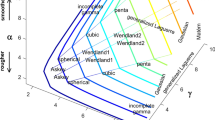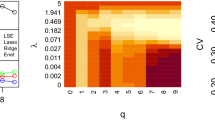Abstract
We develop a new approach to creating covariance functions for Gaussian random fields via point processes on the complex plane. We present two approaches to construct valid covariance functions by exploiting Bochner’s theorem and then modeling the characteristic function of a covariance function. In particular, we use a complex point process (CPP) to model the Fourier coefficients and illustrate how to estimate the covariance function of a Gaussian random field model from data. We further illustrate our construction approaches and compare several algorithms via simulations. The methods are exemplified via applications to real-life research data in wheat yields and earthquake studies.




















Similar content being viewed by others
References
E. M. Airoldi. Getting started in probabilistic graphical models. PLoS Computational Biology, 3(12):e252, 2007. https://doi.org/10.1371/journal.pcbi.0030252.
L. Al Labadi and M. Zarepour. On approximations of the beta process in latent feature models: Point processes approach. Sankhya A, 80:59–79, 2018.
G. Avlogiaris, A. C. Micheas, and K. Zografos. A criterion for local model selection. Sankhya A, 81:406–444, 2019.
D. Allard, L. Clarotto, and X. Emery. Fully nonseparable gneiting covariance functions for multivariate space-time data. Spatial Statistics, 52:100706, 2022.
A. Baddeley and R. Turner. Package ‘spatstat’. The Comprehensive R Archive Network, 2014.
A. J. Baddeley and M. N. M. Van Lieshout. Area-interaction point processes. Annals of the Institute of Statistical Mathematics, 47(4):601–619, 1995. https://doi.org/10.1007/BF01856536.
A. Baddeley, E. Rubak, and R. Turner. Spatial point patterns: methodology and applications with R. CRC press, 2015.
A. Baddeley, T. M. Davies, M. L. Hazelton, S. Rakshit, and R. Turner. Fundamental problems in fitting spatial cluster process models. Spatial Statistics, 52:100709, 2022.
T. Cai and M. Yuan. Nonparametric covariance function estimation for functional and longitudinal data. University of Pennsylvania and Georgia inistitute of technology, 2010.
S Bochner. Vorlesungen uber Fouriersche Integrale. Akademische Verlagsgesellschaft, 1932.
W. Chen, M. G. Genton, and Y. Sun. Space-time covariance structures and models. Annual Review of Statistics and Its Application, 8:191–215, 2021.
N. R. Campbell. The study of discontinuous phenomena. Proc. Cambridge Philos, 15:117–136, 1909.
G. Christakos. On the problem of permissible covariance and variogram models. Water Resources Research, 20:251–265, 1984. https://doi.org/10.1029/WR020i002p00251.
J. Chen, A. C. Micheas, and S. H. Holan. Bayesian modeling and decision theory for non-homogeneous poisson point processes. Spatial Statistics, page 36, 2020. https://doi.org/10.1016/j.spasta.2020.100412.
N. Cressie and H. C. Huang. Classes of nonseparable, spatio-temporal stationary covariance functions. Journal of the American Statistical Association, 94(448), 1999. https://doi.org/10.1080/01621459.1999.10473885.
N.A.C. Cressie. Statistics for Spatial Data. Wiley, New York, rev. ed. 1993 edition, 1991.
P. J. Diggle. Statistical analysis of spatial and spatio-temporal point patterns. CRC Press., 2013.
P. J. Diggle, P. Moraga, B. Rowlingson, and B. M. Taylor. Spatial and spatio-temporal log-gaussian cox processes: extending the geostatistical paradigm. Statistical Science, pages 542–563, 2013. https://doi.org/10.1214/13-STS441.
C. Dutta, K. Karpman, S. Basu, and N. Ravishanker. Review of statistical approaches for modeling high-frequency trading data. Sankhya B, 28:1–48, 2022.
V. Heine. Models for two-dimensional stationary stochastic processes. Biometrika, 42:170–178, 1955. https://doi.org/10.1093/biomet/42.1-2.170.
F. Gerber and D. Nychka. Fast covariance parameter estimation of spatial gaussian process models using neural networks. Stat, 10(1):e382, 2021. https://doi.org/10.1002/sta4.382.
Z. Ghahramani. Probabilistic machine learning and artificial intelligence. Nature, 521(7553):452, 2015. https://doi.org/10.1038/nature14541.
D. Koller and N. Friedman. Probabilistic graphical models: principles and techniques. MIT press, 2009.
M. I. Jordan. Graphical models. Statistical Science, 19(1):140–155, 2004. https://doi.org/10.1214/088342304000000026.
H. R. Kunsch. Statistical analysis of uniformity trials based on parametric models. Unpublished manuscript, Fachgruppe für Statistik, ETH, Zurich, 1985.
A. N. Kolmogorov. The local structure of turbulence in an incompressible viscous fluid at very large reynolds numbers. Doklady Akademii Nauk SSSR, 30:301–304, 1941a.
M. S. Longuet-Higgins. Mass transport in water waves. Philosophical Transactions of the Royal Society of London. Series A, Mathematical and Physical Sciences, 245(903):535–581, 1953. https://doi.org/10.1098/rsta.1953.0006.
F. Lindgren, H. Rue, and J. Lindstrom. An explicit link between gaussian fields and gaussian markov random fields: the stochastic partial differential equation approach. Journal of the Royal Statistical Society: Series B (Statistical Methodology), 73(4):423–498, 2011. https://doi.org/10.1111/j.1467-9868.2011.00777.x.
M Schlather. Construction of covariance functions and unconditional simulation of random fields. In Advances and challenges in space-time modelling of natural events, pages 25–54. Springer, 2012.
E. Lukacs. Characteristic functions. Butler & Tanner Ltd., Frome and London, 1970.
B. Matérn. Spatial Variation. Springer-Verlag, New York, 2 edition, 1986.
A. Mantoglou and J. L. Wilson. The turning bands method for simulation of random fields using line generation by a spectral method. Water Resources Research, 18:1379–1384, 1982. https://doi.org/10.1029/WR018i005p01379.
G. Matheron. Traite de geostatistique appliquée, tome i. Mémoires du Bureau de Recherches Géologiques et Minieres, No.14, 1962.
G. Matheron. The intrinsic random functions and their applications. Advances in Applied Probability, 5:439–468, 1973. https://doi.org/10.2307/1425829.
W. B. Mercer and A. D. Hall. The experimental error of field trials. The Journal of Agricultural Science, 4(2):107–132, 1911. https://doi.org/10.1017/S002185960000160X.
A. B. McBratney and R. Webster. Detection of ridge and furrow pattern by spectral analysis of crop yield. International Statistical Review, 49:45–52, 1981. https://doi.org/10.2307/1403036.
A. C. Micheas. Hierarchical bayesian modeling of marked non-homogeneous poisson processes with finite mixtures and inclusion of covariate information. Journal of Applied Statistics, 41(12):2596–2615, 2014. https://doi.org/10.1080/02664763.2014.922167.
A. C. Micheas. Cox point processes: Why a sample size of one is not enough. International Statistical Review, 87(2):306–325, 2019. https://doi.org/10.1111/insr.12308.
A. C. Micheas and J. Chen. sppmix: Poisson point process modeling using normal mixture models. Computational Statistics, pages 1–32, 2018. https://doi.org/10.1007/s00180-018-0805-z.
J. Møller. Spatial Statistics and Computational Methods. Lecture Notes in Statistics. Springer-Verlag, New York, Inc., 2003.
S. C. Pearce. An examination of fairfield smith’s law of environmental variation. The Journal of Agricultural Science, 87:21–24, 1911. https://doi.org/10.1017/S0021859600026538.
J. Møller and K. Helisova. Likelihood inference for unions of interacting discs. Scandinavian Journal of Statistics, 37(3):365–381, 2010. https://doi.org/10.1111/j.1467-9469.2009.00660.x.
E. Pebesma, B. Graeler, and M. E. Pebesma. Package ‘gstat’, 2019.
T. Poggio and F. Girosi. Networks for approximation and learning. Proceedings of the IEEE, 78(9):1481–1497, 1990. https://doi.org/10.1109/5.58326.
T. Richardson and P. Spirtes. Ancestral graph markov models. The Annals of Statistics, 30(4):962–1030, 2002. https://doi.org/10.1214/aos/1031689015.
B. D. Ripley. Spatial Statistics. Wiley, New York, 1981.
M. L. Stein. Space-time covariance functions. Journal of the American Statistical Association, 469:310–320, 2005.
M. L. Stein. Nonstationary spatial covariance functions. Unpublished technical report, 2005.
D. J. Strauss. A model for clustering. Biometrika, pages 467–475, 1975. https://doi.org/10.1093/biomet/62.2.467.
M. N. M. Van Lieshout. Markov point processes and their applications. World Scientific, 2000.
A. V. Vecchia. A general class of models for stationary two-dimensional random processes. Biometrika, 72:281–291, 1985. https://doi.org/10.1093/biomet/72.2.281.
F. Vivarelli and C. K. Williams. Discovering hidden features with gaussian processes regression. Advances in Neural Information Processing Systems, pages 613–619, 1999.
P. Whittle. On stationary processes in the plane. Biometrika, 41:434–449, 1954. https://doi.org/10.2307/2332724.
P. Whittle. Topographic correlation, power-law covariance functions, and diffusion. Biometrika, 49:305–314, 1962. https://doi.org/10.1093/biomet/49.3-4.305.
C. K. Williams and C. E. Rasmussen. Gaussian processes for machine learning. Cambridge, MA: MIT Press, 2006.
W. Wu and A. C. Micheas. Modeling fourier expansions using point processes on the complex plane with applications. Communications in Statistics-Simulation and Computation, pages 1–18, 2022. https://doi.org/10.1080/03610918.2022.2069818.
A. Zhigljavsky and A. Žilinskas. Selection of a covariance function for a gaussian random field aimed for modeling global optimization problems. Optimization Letters, 13(2):249–259, 2019. https://doi.org/10.1007/s11590-018-1372-5.
Acknowledgements
We are grateful to an anonymous referee for their constructive comments and suggestions.
Funding
There is no source of funding for this research.
Author information
Authors and Affiliations
Corresponding author
Ethics declarations
Conflict of Interest
The authors have no conflicts of interest regarding this research.
Additional information
Publisher's Note
Springer Nature remains neutral with regard to jurisdictional claims in published maps and institutional affiliations.
Appendix
Appendix
1.1 Proof of Theorem 2
Proof
Since the covariance function is defined on \(r\in [0,+\infty )\), with \(\rho (x_1,x_2)=\rho (r)=\rho (||x_1-x_2||)\), condition (2) in Pólya’s condition is automatically satisfied.
When the covariance function and all of the functions \(\theta _k(r), k=0,1,2,3,4,5\), are twice continuously differentiable, and we only use a window with \(x\ge 0\), the expectation will be convex if
that is,
and thus when condition (1) in the theorem holds, this integral is guaranteed to be non-negative, and the expectation is convex.
Note that if
for \(r\ge 0, x\in A, y\in B\) almost surely, the expectation is convex, since
For condition (4) in Pólya’s conditions, we need \(\lim _{r\rightarrow \infty }E(\hat{\rho }(r))=0\), which implies that
or
and therefore when condition (2) in the theorem holds, i.e.,
for \(x\in A, y\in B\) almost surely, we have
Thus the expectation follows conditions (2), (3), and (4) of Pólya’s conditions and therefore, it is a positive semi-definite function. \(\square \)
Rights and permissions
Springer Nature or its licensor (e.g. a society or other partner) holds exclusive rights to this article under a publishing agreement with the author(s) or other rightsholder(s); author self-archiving of the accepted manuscript version of this article is solely governed by the terms of such publishing agreement and applicable law.
About this article
Cite this article
Wu, W., Micheas, A.C. A New Construction of Covariance Functions for Gaussian Random Fields. Sankhya A 86, 530–574 (2024). https://doi.org/10.1007/s13171-023-00336-4
Received:
Published:
Issue Date:
DOI: https://doi.org/10.1007/s13171-023-00336-4




